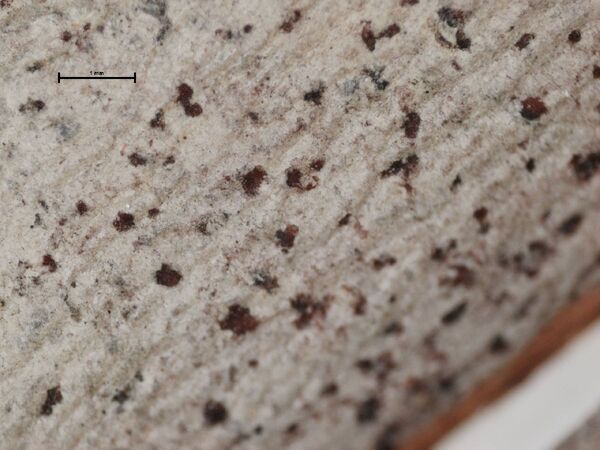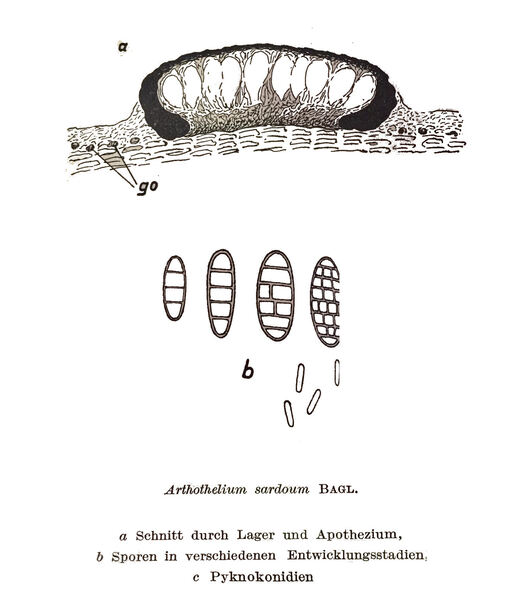Arthonia beccariana (Bagl.) Stizenb.
Ber. Tätigk. St. Gall. naturw. Ges. 1889/1890: 200, 1891. Basionym: Arthothelium beccarianum Bagl. - N. Giorn. Bot. Ital., 7: 252, t. 9, fig. 14, 1875.
Synonyms: Arthonia beccariana f. leprosa (Bagl.) Stizenb.; Arthonia sardoa (Bagl.) H. Olivier; Arthothelium beccarianum var. leprosum Bagl.; Arthothelium beccarianum var. opegraphoides Bagl.; Arthothelium pruinascens Zahlbr.; Arthothelium sardoum Bagl.
Distribution: C - Tosc, Laz, Sar (Grube & Giralt 1996). S - Camp, Pugl (Durini & Medagli 2004), Cal (Puntillo 1995, 1996, Grube & Giralt 1996), Si (Nimis & al. 1994, Caniglia & Grillo 2006b).
Description: Thallus crustose, not lichenized, very thin, usually continuous, white to pale grey. Apothecia arthonioid, scattered, rounded to slightly elongate, 0.3-0.5 mm, level with thallus, blackish, matt, 80-100 μm thick, rarely with an irregularly distributed yellowish purple pruina reacting K+ purplish violet. Epithecium layer olivaceous brown, 10-15 μm high; hymenium colourless, c. 30 μm high, I+ persistently blue, K/I+ blue; paraphysoids anastomosing, richly branched in upper part, c. 1 μm thick; hypothecium colourless to pale brown, 10-20 μm high. Asci 8-spored, broadly clavate to subglobose, semi-fissitunicate, with a large apical dome and a distinct ocular chamber, the apex with a K/I+ blue ring-structure, Arthonia-type. Ascospores muriform, with 5-8 transverse septa and (1-) 2-3(-4) longitudinal septa in each of the tranverse segments, hyaline turning pale brown when overmature, obovoid, 18-22(-25) x 10-12 μm. Pycnidia frequent, brownish, more or less hemispherical. Conidia bacilliform, straight or curved, (4-)5-7 x c. 1.5 μm. Photobiont: absent. Spot tests: thallus K-, C-, KC-, P-, UV-. Chemistry: thallus without lichen substances.Note: a mild-temperate, non-lichenized species also reported from California, found on smooth bark of broad-leaved trees in sites subject to humid maritime winds, mostly in the Mediterranean belt. Restricted to a few sites in Tyrrhenian Italy.
Growth form: Fungus
Substrata: bark
Reproductive strategy: mainly sexual
Most common in areas with a humid-warm climate (e.g. most of Tyrrenian Italy)
Taxon bound to maritime-coastal situations
Commonnes-rarity: (info)
Alpine belt: absent
Subalpine belt: absent
Oromediterranean belt: absent
Montane belt: absent
Submediterranean belt: absent
Padanian area: absent
Humid submediterranean belt: absent
Humid mediterranean belt: very rare
Dry mediterranean belt: absent

Predictive model
Herbarium samples
Growth form: Fungus
Substrata: bark
Reproductive strategy: mainly sexual
Most common in areas with a humid-warm climate (e.g. most of Tyrrenian Italy)
Taxon bound to maritime-coastal situations
Commonnes-rarity: (info)
Alpine belt: absent
Subalpine belt: absent
Oromediterranean belt: absent
Montane belt: absent
Submediterranean belt: absent
Padanian area: absent
Humid submediterranean belt: absent
Humid mediterranean belt: very rare
Dry mediterranean belt: absent

Predictive model
| Herbarium samples |
 Index Fungorum
Index Fungorum
 GBIF
GBIF



